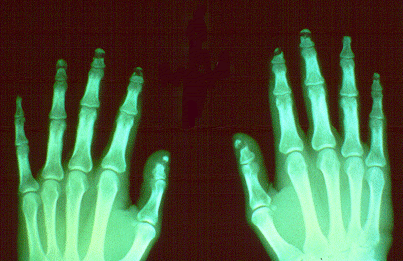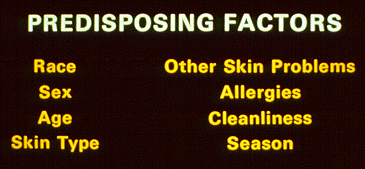Occupational Dermatoses
NOTE: This page is archived for historical purposes and is no longer being maintained or updated.
Slides 86 to 90
Slide 86 - Acroosteolysis, clinical

Acroosteolysis or shortening of the terminal digits, as the left thumb and right forefinger show here, has been observed among polyvinyl chloride reactor workers who enter vessels to chip away hardened resin. In addition to the acroosteolysis, Raynaud's pnenomenon and scleroderma-like skin may occur as components of a triad.
Slide 87 - Acroosteolysis, x-rays

Early changes of acroosteolysis can be detected by x-ray. In this radiograph there is dissolution and fragmentation of the bone in several of the terminal phalanges.
Slide 88/89 - Drug interaction/Degreasers' flush
This photo was removed due to privacy concerns.
Degreasers' flush can occur in workers imbiding alcohol following industrial exposure to trichloroethylene (TCE) vapor. The subject shows the appearance of normal facial skin after exposure to trichloroethylene, and shortly after beginning to drink beer. Forty-four minutes later, the flush is very apparent. The dermal response of flush reaches maximum intensity 30 minutes after onset and fades within 60 minutes.
Slide 90 - Predisposing factors

In recognizing the clinical pattern of skin disease, it is always important to consider possible occupational etiology. This includes the employee, as well as the occupational setting. These factors include: race, sex, age, skin type, presence of other skin problems, history of allergies, cleanliness and seasonal variations.
- Page last reviewed: January 5, 1998 (archived document)
- Content source:
- National Institute for Occupational Safety and Health Health Effects Laboratory Division (HELD)


 ShareCompartir
ShareCompartir